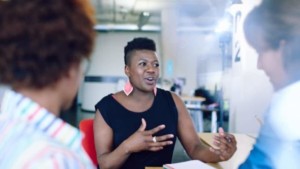Four Ways Blended PD Makes Teachers Ready for the Classroom

By Dr. Michael Moody
Providing teachers with professional development and support that actually works is a significant and critically important challenge we must tackle head on. And the use of technology is starting to show signs of delivering on the promise of truly helping teachers improve their practice.
Before technology even comes into the equation though, we need to start engaging in observation and evaluation cycles for teachers with the frequency and regularity that we do with students. In order to truly impact classroom practice, teacher feedback and coaching (and even evaluation) need to be formative, taking place regularly throughout the school year.
Someone coming into your classroom for an hour or two each year is not going to help you to grow. Optimally, teachers should be coached by someone (not necessarily formally) 3-4 times per month. But this requires us to think about who provides support and how they do it. And leveraging everyone as a coach—school leaders, colleagues and instructional coaches—is key to the process.
However, establishing a system of support that is formative and effective is hard to pull off, particularly when we’re bound by the “traditional” structures of the school and the school day. This is where technology can help. Observation and support platforms help to streamline the logistics while providing opportunities to leverage video in ways that remove the barriers and allow all practitioners to focus on the tasks that matter most: watching and discussing instruction to identify areas for growth and monitor progress over time.
I’ve recently taken to calling this a “blended” approach to teacher support—leveraging both in-person coaching and technology. This approach, when implemented effectively, can create an “ecosystem of support” by engaging teachers in learning with school leaders and peers. And perhaps even more exciting is the opportunity to self-reflect in ways that haven’t been utilized before.
Principals as Coaches: Are They ready?
We’ve always expected the school leader to serve as the primary support for teachers in their building. However, many leaders may fall short of these expectations if they don’t have the right tools—or content knowledge—to coach effectively. Just as student readiness begins with teacher readiness, teacher readiness begins with principal readiness.
In our work across the country, instructional rubrics are generally guiding the work of expectation-setting and support. But we sometimes forget that, in many cases, it’s been awhile since the leader was a teacher. They haven’t necessarily had to teach with new standards or increased accountability. Thus, supporting school leaders in their own growth is as critical as supporting teachers. And supporting leaders in their work is particularly challenging, as it’s not so easy to “observe” a principal in action.
We’ve recently begun using some of the same support structures for principals and coaches as we have with teachers—using video of their coaching conversations with teachers to provide coaching to the coaches. If we truly believe that teacher feedback is going to improve practice, then it only makes sense that this would apply to those who support teachers as well.
Video has begun to not only help teachers, but all involved in the process. The benefit of video observation lies in its objectivity. In the typical observation model, the principal and teacher are both relying on the principal’s recollection of the lesson and notes, which could be tainted by personal perception. Video removes the barrier of subjectivity so both parties can watch at the same time and work together on identifying both strengths and areas for growth. This turns coaching into a collaborative process, rather than a combative one—or worse yet, a neutral conversation with no lasting impact.
Peer-Reflection
Peer collaboration, or PLCs in many schools, have also popped up as a way to engage teachers in learning. And while this can be an effective structure, it is not without its implementation challenges. The use of video removes logistical barriers and allows more than one person to engage in feedback, without having to get teachers into each other’s classrooms. More collaboration leads to better feedback. This same thing could be achieved by having the principal and multiple teachers sit in the back of a teacher’s classroom, but the logistics of finding substitutes and the distraction for the students makes video a far better solution. With video, all teachers need to do is film themselves.
With video, teachers can get feedback from their colleagues during non-school hours. They can also share short snippets, rather than having colleagues review a whole lesson. For instance, if a teacher is having trouble with transitions, she can tape only the transitions for another teacher to review. This leads to specific, actionable feedback, turning occasional opportunities to observe into a formative process.
Teacher-to-teacher observation enables low-stakes, high-frequency feedback from people who are in the same position as the observee. Peer feedback is not only beneficial to the teacher receiving it; the teacher providing feedback also benefits (and learns) from the process.
Self-Reflection
In all of my time as a teacher, I never saw myself teach. Self-reflection meant that I’d think back on a lesson and try to figure out what I might have done differently. Video is proving to be extremely beneficial for self-reflection. I had one school leader recently tell me that he had a teacher “gaming the system” by filming a lesson, watching it and changing the lesson prior to submitting it for feedback. To me, this isn’t gaming the system—it’s a powerful form of self-reflection. That teacher is actually facilitating their own PD and making their own improvements. And this can happen without anyone else’s involvement.
People are most critical of themselves, but self-critique is challenging for teachers unless they can see themselves in action. Video empowers teachers to review their own practice by looking at it from the outside.
Training Pre-Service Teachers
All the benefits discussed so far also apply to pre-service teachers, and video is even more essential for this group, since those giving them feedback are not even present at the school where the pre-service teachers are teaching. Video provides an opportunity for teacher preparation programs to more effectively and frequently engage in the feedback process from both supervisors and other pre-service teachers—and offering feedback to their peers helps student teachers improve their practice.
When it comes to pre-service teachers, frequent feedback cycles are proving to promote more growth. However, this is sometimes hard to achieve given the way that programs are structured with observational visits happening infrequently. Pre-service teachers have a million little things they’re trying to figure out how to fix, and with more frequent coaching cycles (or shorter videos sent to their support provider at more frequent intervals), they can get very specific feedback. Fixing little things along the way is easier than fixing a lot of things all at once.
Pre-service teachers are a unique group, since they are teachers, but they are also still students. This makes them particularly receptive to feedback, because they still have a learner mentality. If we could hold onto the learner mindset after leaving school, everyone would learn more—and be more ready to do their best in the classroom.
We know from current research—and being teachers ourselves—that there is definitely room to improve our systems of support. And we also know that some schools and districts are doing a great job of engaging teachers in continuous learning. It’s time for us to look around, find examples of truly effective job-embedded professional development and challenge ourselves to build, or rebuild, these processes to reflect what we know will be good for the teachers we serve. Our kids deserve teachers who are the best they can be, and this will only happen if professional support capitalizes on a blended model.
Dr. Michael Moody is the Founder and CEO of Insight ADVANCE, and a former classroom teacher and school and district administrator. Follow him on Twitter: @DrMichaelMoody
For more, see:
- Four Key Ingredients For The Teacher PD Revolution
- Three Tips for Leaving Your Classroom Island
- Is Student Learning Directly Impacted By Teacher PD?
Stay in-the-know with all things EdTech and innovations in learning by signing up to receive the weekly Smart Update.









0 Comments
Leave a Comment
Your email address will not be published. All fields are required.